People with kidney disease are often told to eat a low phosphorus diet. Unfortunately, most do not get much guidance about how to go about the low phosphorus diet or why too much phosphorus could be harmful. This post will help you understand how to eat a low phosphorus diet and why it is important.
Most importantly, much of the information about a low phosphorus diet is out of date. Recently, there has been a huge shift in how kidney dietitians and doctors approach the low phosphorus diet. Outdated information about the low phosphorus diet causes a lot of confusion for patients. It also results in dangerous, unnecessarily restrictive eating plans. Because of new research, we now know that many of the foods people were traditionally told to avoid on a low phosphorus diet are actually good for kidney disease! How can this be?
This article will also help you understand the new recommendations for a low phosphorus diet and why the recommendations have changed.
Table of Contents
What Is Phosphorus?
Phosphorus is a mineral found in most foods we eat and is an important part of our bodies. We need phosphorus to create energy, keep our bones healthy, metabolize our food, and have proper nerve and heart function. (1)
Phosphorus and Kidney Disease
It is the kidney’s job to remove excess minerals, like phosphorus, sodium, magnesium, calcium, and potassium from our bodies. Most of these minerals come from our food. In Chronic Kidney Disease (CKD), the kidneys cannot get rid of these minerals as well. And, there is no other effective way to get rid of them. Because of this, minerals like phosphorus can build up in our bodies and cause harm.
Even small increases in phosphorus can be damaging. High phosphorus signals an imbalance in hormones that regulate bone health. In medical terms, this imbalance is called “CKD Bone and Mineral Disorder”. CKD Bone and Mineral Disorder leads to weak bones and a higher risk of stoke and heart disease.
Healthy bones are in a continuous cycle of breaking down and rebuilding. In CKD Bone and Mineral Disorder, abnormal levels of phosphorus, calcium, parathyroid hormone (or “PTH”), a hormone called FGF-23 and vitamin D cause our bones to “turnover” too often. High bone turnover makes it harder for bones to repair themselves, which causes weak bones. In addition, all this bone turnover releases calcium from bones into the blood, which can lead to calcification of soft tissues. This calcification increases the risk of stroke and heart attacks. (1)
Who Should Follow a Low Phosphorus Diet?
Kidney Disease
Phosphorus often isn’t brought up in conversation until a person has very advanced kidney disease. However, CKD Bone and Mineral Disorder can start even before the level of phosphorus in your blood starts to go up. (1) Kidneys are less efficient at getting rid of phosphorus very early in kidney disease. Even people with high GFR (Glomerular Filtration Rate) over 60ml/min are more likely to have slightly high levels of phosphorus. (2)
Because of this, I recommend that everyone with kidney disease avoid artificial phosphorus (read on to learn more about what this is and how to avoid it). Artificial phosphorus has no benefit and is the biggest contributor (up to 50%) to our total phosphorus intake. (3)
Natural sources of phosphorus, especially plant sources, are not a concern for most people. Keep reading to learn more about natural phosphorus. Avoiding artificial phosphorus is enough to keep phosphorus intake in a healthy range for most people. This is especially true for people with CKD stages 1-3.
For people with CKD stages 4-5, or who are on dialysis, natural phosphorus may need to be avoided. Your diet patterns and lab results help determine the specific foods that you should eat. Unfortunately, there is not a black and white answer to what natural sources of phosphorus should be cut out. It is critical to work with a Registered Dietitian who knows your medical history and labs to figure out what is right for you.
Heart Disease
Higher levels of phosphorus have been linked to heart disease even in people without kidney disease. (1) However, more research needs to be done to determine the cause and effect relationship here. We do not know if avoiding dietary phosphorus reduces the risk of heart disease.
Regardless, it is good practice for people with heart disease to avoid artificial phosphorus. Artificial phosphorus tends to be in processed foods that are not healthy for us for other reasons.
How Much Phosphorus Should I Eat?
Learning about the dangers of high phosphorus in CKD can be scary. But please remember that you DO NOT need to completely cut phosphorus out of your diet. Your body needs phosphorus to function; it would be unhealthy to completely cut it out. The problem comes with eating much more phosphorus than your body needs.
Recommendations for phosphorus for people with kidney disease are changing. The 2012 guidelines from the National Kidney Foundation recommended that people with kidney disease (who are not on dialysis) eat 800-1000mg of phosphorus. (4) For comparison, the average phosphorus intake in the United States is around 1200-1400mg per day. (5)
New guidelines from the National Kidney Foundation came out in 2020. These guidelines no longer recommend the absolute 800-1000mg phosphorus recommendation. Instead, the guidelines highlight the “bioavailability of phosphorus food sources”. (6) Bioavailability refers to how much phosphorus is absorbed from the foods we eat. This change reflects new research and a different approach to the low phosphorus diet.
Rethinking the Low Phosphorus Diet
We now know that phosphorus found naturally in foods is not very well absorbed (or has lower “bioavailability”), compared to artificial phosphorus found in food additives. (6) (7)
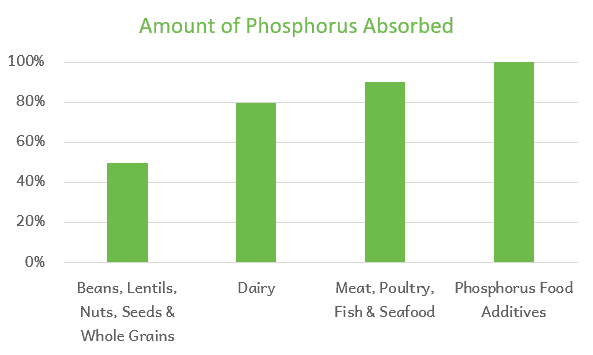
The difference in absorption can make a huge difference in how much phosphorus actually ends up in your body! For example, if someone ate 1000mg of phosphorus mostly from beans and whole grains, only 500mg would make it into our bodies. If that 1000mg of phosphorus was from fast food (which tends to be very high in artificial phosphorus), almost all 1000mg would make it in.
The lower availability of phosphorus in natural food sources, combined with the health benefits of foods naturally high in phosphorus, is leading to a shift in what a healthy low phosphorus diet looks like.
Finding Artificial Phosphorus
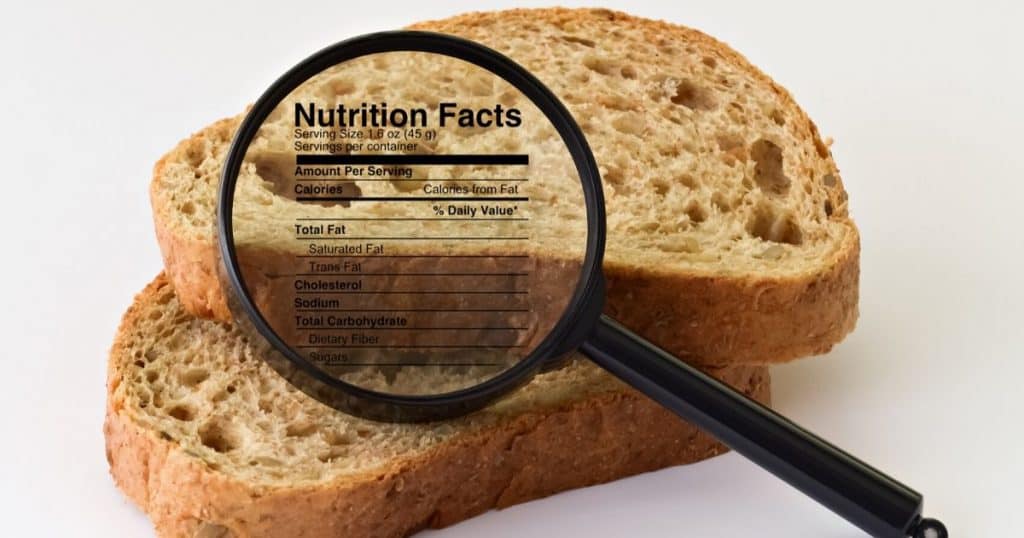
I use the term “artificial phosphorus” to refer to phosphorus found in food additives. Phosphorus is part of many chemicals that are added to our food for stability, taste, color, and preservation. (8) Phosphorus food additives are very common in the foods we eat. And, these have been added to our foods even more frequently in recent years.
Unfortunately, phosphorus is not explicitly listed on Nutrition Labels for most products in the United States. You are not able to simply read how much phosphorus is in a food by looking at the label, as you would for calories, sodium or fiber.
Instead, the best way to figure out if a product has a phosphorus food additive in it is to read the ingredients, usually located at the bottom of the Nutrition Facts label. Look for any ingredient that has the letters “PHOS” in it. You want to avoid products that have “PHOS” in any part of the word.
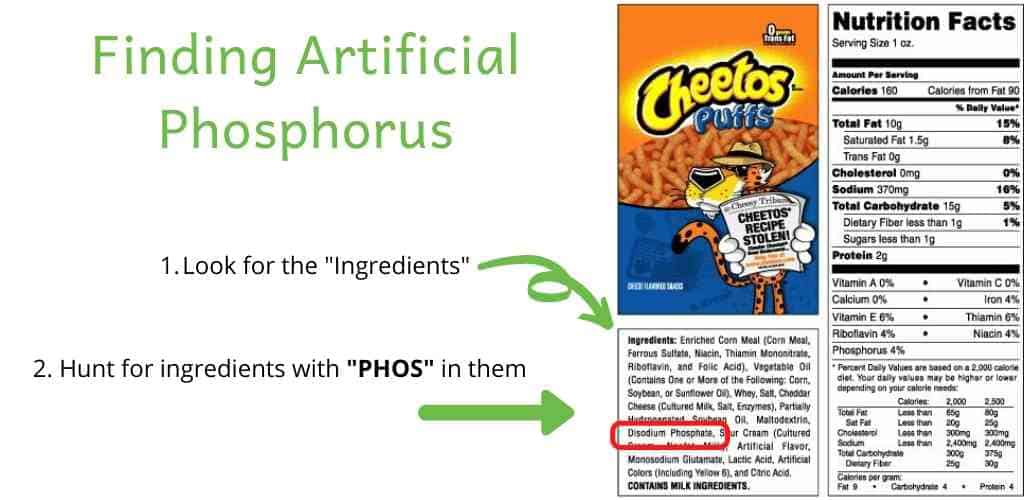
Some of the most common food additives that contain phosphorus: (9)
- Dicalcium phosphate
- Disodium phosphate
- Monosodium phosphate
- Phosphoric acid
- Sodium hexameta-phosphate
- Trisodium tripolyphoshate
- Tetrasodium pyrophosphate
I recommend checking every food label you come across for “PHOS” ingredients. You never know what kinds of foods phosphorus sneaks into!
There are types of food products that those “PHOS” ingredients are commonly found in:
- Ultra processed meats (lunch/deli meat, hot dogs, sausages, bacon, ham, corned beef, etc.)
- Ultra processed cheeses (American cheese, Velveeta, nacho cheese sauce, etc.)
- Cola (both regular and diet)
- Frozen or refrigerated prepackaged foods (think chicken nuggets, French fries, frozen dinners, rolls, pies, appetizers, etc.)
- Snack mixes (cheese puffs, chips, pub mix, etc.)
- Shelf stable prepared foods (box macaroni and cheese, canned stew or baked beans, pasta or rice with sauce, instant mashed or flavored potatoes, etc.)
- Sauces & Condiments (salad dressing, commercial marinades, jarred gravy or sauce, etc.)
- Commercial desserts (commercially produced cookies, cakes, pies, etc.)
The Old Low Phosphorus Diet
The traditional low phosphorus diet restricts both natural and artificial sources of phosphorus. Natural sources of phosphorus include whole grains, nuts, seeds, legumes, dairy and chocolate.
We now know that many of these foods are actually good for kidney disease. Plant proteins like beans, lentils, nuts and whole grains have actually been shown to slow the progression of kidney disease. They are also good for health conditions common in people with kidney disease such as acidosis, diabetes, and heart disease.
The New Low Phosphorus Diet
The new low phosphorus diet primarily focuses on avoiding artificial phosphorus. Artificial phosphorus is where most of the phosphorus in our diet comes from. In most people, simply avoiding artificial phosphorus results in healthy phosphorus levels. This allows people with kidney disease to enjoy many more healthy, delicious foods!
Natural sources of phosphorus like nuts, beans, lentils, seeds, and whole grains are actually encouraged on the new low phosphorus diet!
Meat & Eggs in the Low Phosphorus Diet
Meat and other animal proteins like poultry, fish and seafood have significant amounts of phosphorus. If avoiding artificial phosphorus is not enough to bring phosphorus levels to normal, this is the next place to tackle.
CKD Stages 1-5 (without dialysis)
People who have CKD who are not on dialysis should limit how much protein they eat. This is because high protein diets can make kidney disease progress faster. (10) The National Kidney Foundation recommends limiting protein to 0.6-0.8 grams per kilogram body weight per day. (5)
Because of their high protein and phosphorus content, meat, chicken, turkey, fish, seafood, and eggs should be eaten in smaller portions. Healthy portion sizes of meat are different for everyone. For most people, aiming for no more than 3-6 ounces of meat per meal is a good goal. Or, think about a portion ½ the size of the palm of your hand. For eggs, aim for 1-2 per meal.
End Stage Renal Disease (people on dialysis)
For people who are on dialysis, protein needs are much higher. The National Kidney Foundation recommends up to 1.2 grams of protein per kilogram body weight. (5) Work with your dietitian to figure out what meat portion size is best for you!
Dairy in the Low Phosphorus Diet
Cow’s milk, and therefore all dairy, also has quite a bit of phosphorus in it. For people with CKD stage 4-5 or who are on dialysis, it is a good practice to limit dairy to ½-1 cup per day. Of course, you should ask your dietitian what’s best for you.
Rice and almond milk are lower in phosphorus compared to cow’s milk and make excellent substitutes. But, be careful to avoid artificial phosphorus in the brand that you buy! Check out this great article about milk and kidney disease.
Bottom line: the healthy amount of meat and dairy will be different for everyone depending on your level of kidney function, body size and medical history. As always, work with your dietitian to figure out what is best for you!
Healthy Drinks in the Low Phosphorus Diet
Beverages can be a surprising source of phosphorus in our diets! Remember, artificial phosphorus is not limited to food!
You’ll find artificial phosphorus in cola (both regular and diet), some flavored waters, iced teas, and other commercial drinks.
Phosphorus is very different even for different flavors of the same brand of product. For example, Crystal Light Blackberry Lemonade does not have added phosphorus, but Crystal Light Raspberry Lemonade does. Note that almost all Crystal Light products have added potassium too!
Of course, the best drink for nearly everyone is old fashioned water. However, we all need to mix it up sometimes! Most unsweetened, flavored carbonated waters do not have artificial phosphorus. Or, even having an occasional diet clear soda such as Sprite or 7-Up is okay as well. Make your own iced tea or lemonade at home to avoid artificial phosphorus. Try infusing your water with fruits or herbs (strawberry basil is my favorite!).
Low Phosphorus Foods
How do we put all this information together? Here is a list of low phosphorus foods I recommend for a low phosphorus diet. This information is also available as a Low Phosphorus Diet PDF.
| Foods Recommended on a Low Phosphorus Diet | Foods NOT Recommended on a Low Phosphorus Diet | |
|---|---|---|
| Proteins | 3-4oz portions fresh or frozen meat, turkey, fish & seafood | Processed meat (deli meat, bacon, sausage, hot dogs, corned beef, salami) |
| 1/2 cup portion beans, lentils, legumes or tofu | Breaded or fried meats | |
| 1-2 tablespoons nut butter | Organ meats (liver, kidney) | |
| 1-2 eggs | Meat, fish and chicken from fast food restaurants | |
| Rice milk | Large amounts of cow’s milk | |
| Dairy | Almond milk | Processed cheese like Velveeta®, American or Cheez-Whiz® |
| Natural cheeses like mozzarella, Swiss, goat or cheddar | Milk substitutes with phosphate additives | |
| Grains | Whole Wheat Bread & Pasta | |
| Brown Rice | Grain products with artificial phosphorus. Look out for: | |
| Oatmeal, cream of wheat & grits | Flavored rice/pasta mixes | |
| Whole grain cold cereals (bran flakes, cheerios, wheat Chex®) | Bread/cake/muffin/pancake mixes | |
| Macaroni & Cheese | ||
| Commercially made cornbread, muffins and other baked goods | ||
| Fruits & Vegetables | All fruits & vegetables are naturally low in phosphorus! | Breaded or fried vegetables |
| Vegetables with creamy sauces | ||
| The exception is beans, lentils and legumes. Check out recommendations for these in “proteins” | Vegetables or fruits in frozen/canned prepared food | |
| Dried fruit with added phosphorus | ||
| Desserts | Sherbet or sorbet | Ice cream or pudding |
| Fruit crisp or pie | Commercially made cakes, cookies, pies with artificial phosphorus | |
| Homemade cookies or cake | ||
| Fruit | ||
| Drinks | Water! | Cola |
| Clear soda | Drinks with artificial phosphorus | |
| Homemade unsweetened iced tea |
Low Phosphorus Diet Final Thoughts
For most people, learning about the new low phosphorus diet is refreshing! If you focus on limiting artificial phosphorus, there is plenty of room for healthy foods like beans, nuts and lentils.
This is great news because we know that plant proteins are associated with slower progression of kidney disease. (10) Also, perhaps most importantly, the new low phosphorus diet is less restrictive. A less restrictive diet helps people enjoy food (and life!) and helps people stick with a healthy eating plan. This is great news for everyone.
Happy Eating!
Melanie

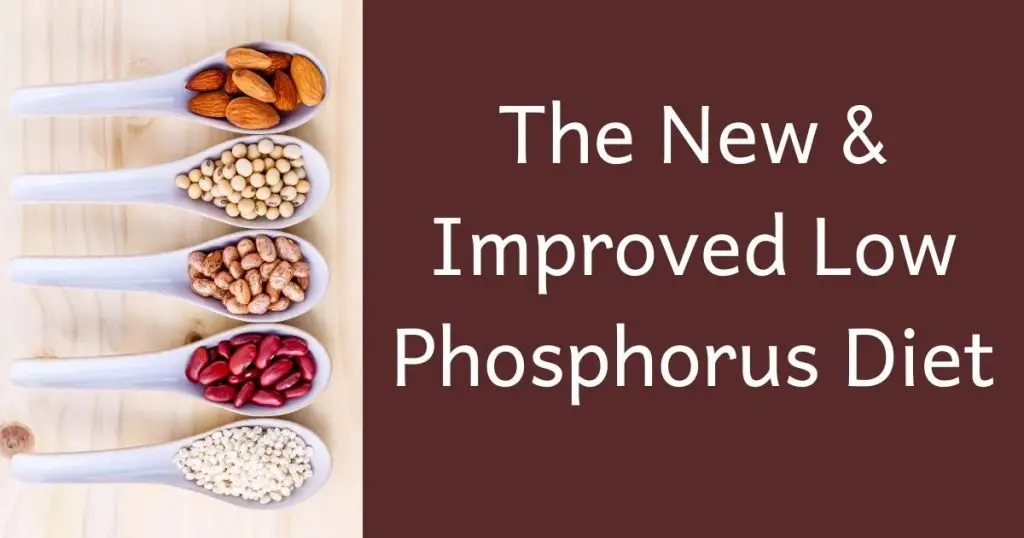
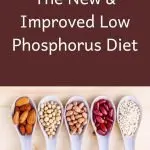
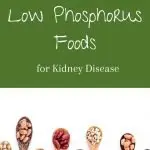
Thank you. This has helped me a lot.
I’m so glad! Thanks for taking the time to let me know.
Hi,
Thanks for info!!!
Three questions –
Must all food companies that include the addition of phosphorus (of some kind) list it on their products?
Are chia and flax seeds okay in cereal (mine is made by Kind)?
With “ice cream” made largely from coconut milk
what items used making it, aside from low sugar,
should I be on the lookout for?
Hi Julie! Food companies must list all ingredients. We can’t always know which of them include artificial phosphorus, but reviewing the ingredient list as I recommend here is a VERY good to get some idea. I can’t say what is ok for you as it completely depends on your labs, stage of kidney disease and all the other foods you typically eat. I’d highly recommend working with a renal dietitian to get all of these specific questions answered – here is a list of people I recommend!
Thank you for sharing this. The nutritionist I went to was adamant it was incorrect, but also I know it’s when I went to basically vegetarian with some animal proteins but no processed meals my eGFR dramatically improved.
I was confused on the pdf chart that had frozen fruit in the “avoid” section. I don’t see any phosphorus in the frozen fruit I purchase, so don’t if there’s another reason to avoid
No reason to avoid frozen fruit! Some of it might have added sugar (I’ve never seen phosphorus – but I suppose there is ALWYAS a chance!) – but most if it is a wonderful option!
Dear Melanie,
I can’t thank you enough for this wonderful article about phosphorus. It has so much good information that is clearly written and easy to understand. I’m going to print it and put it on my refrigerator, so that I can refer to it to make healthier food choices and hopefully have less pain thanks to you.
Blessings to you and thanks again for these wonderful articles that help us to manage our CKD.
Yvonne
Melanie,I find all your articles full of useful information, I’ve been able to change up my diet some! thankyou so much, keep them coming!!!
Thank you so much! I’m so glad my content has been helpful to you!
Barbara Calhoun … we need your background and voice to those who control our food intake. I do hope you are able to get a foot in the door and have a loud voice in the matter of what is in the food we purchase to put in our bodies. I can’t maintain a garden and I am unable to do a lot of cooking and baking, anymore. The microwave is such a wonderful kitchen appliance but I use it very little because of what I read on the labels for microwaveable food packages. OUR GENERATION (75+) NEEDS HELP, NOW.
Hello Darlene,
Thank you for your reply. Sometimes I feel like I’m living in a boat held afloat by chemical phosphate additives.
Yes, almost all frozen entrees are laced with some sort of phosphorus additive. More and more foods are being laced with these additives. Rice Milk, for example, was once a great milk alternative until they “improved” it and it is now referred to as “Organic” “enriched” Rice Milk One of these “enrichments” is, of course, tricalcium phosphate. This begs the question: In what universe is tricalcium phosphate organic? I called them on this and received no response. Cream of Wheat did the same thing. I’ve been eating Cream of Wheat for over 80 years and was appalled to recently note they are now adding Ferric Orthophosphate (Iron), I also called them on this and got some nonsense answer. My efforts so far have produced no results. I’m going to try the USDA and FDA next. Someone needs to start listening. I wish you well with your fight to overcome CKD.
Is Morningstar Farms plant based meat a good substitute. I have been trying to cut back on eating meat. This as a substitute does help I just watch the sodium content and try to eat less than the recommended amount.
You always just want to look for those phos ingredients! I think that some of these plant based meat substitutes can fit for most people!
This list goes against many I have seen. Brown rice,whole wheat bread,eggs are not good for a kidney diet. Many lists say these items are no-nos. I suggest any one reading this to keep doing research.
Hi Wes! It sounds like you are using lists from the outdated guidelines, as discussed in this article. We now know that the phosphorus from whole grains and other plant foods is not well absorbed and are actually GOOD for most people with kidney disease.
Is the Costco frozen organic vegetables also not recommended, or is it only not recommended for conventional frozen vegetables? Thanks!
If vegetables are organic or not doesn’t impact the phosphorus content! Always check ingredient labels for sodium and phos additives to be sure.
Thank you for this article. This is the first that has mentioned the updated guidelines about phosphorus. It definitely eases some anxiety for me. Well done!
Yay! I’m so glad to help.
Thank you for the information. I’m a new dialysis patient and it’s so confusing.
So far none of the binders agree with me so I have to modify my food intake. I’m very disappointed in the place I go.. especially their nutritionist… might as well be talking to a box of rocks. All they want to do is throw me pills and send me on my way. You have to be your own advocate!!
Thank you for the attention you’ve paid to the effects of chemical phosphates in foods. Since phosphorous additives are such a huge danger to 35 million+ CKD patients, and food processors are so sneaky about how much is in the food they sell, why haven’t the national kidney organizations become proactive in lobbying the FDA, USDA, other involved regulatory agencies (and indeed the food processors themselves) to stop using these chemicals? There are other less harmful peservatives that can be used instead. At the very least the food processors should be required to be more transparent by listing phosphorus in the label’s nutrient section, along with the actual amount in the product. Phosphate additives have become so commonplace that I recently found a half dozen or so products that previously contained no phosphates to now contain phosphates. The only notification consumers get of the addition is usually a label that states “New and Improved” or “better taste.” Surely the food processors should be concerned about 35 million+ customers and potential customers? As a consumer and Stage 4 CKD patient what can I do to influence the national kidney organizations and the government to lobby the food industry to stop or modify the food industry’s practice of using this dangerous chemical in their products? My apologies for the lengthy comments but this has long been an issue of great concern to me..
Oh my goodness! I LOVE your enthusiasm. I completely agree this is a big issue for SO many people. I don’t have any specific advice for you, other than reaching out to your representative and sharing your concerns. I would be worth reaching out to the National Kidney Foundation as well to see if you can spearhead any advocacy efforts – I don’t know of any currently happening. It is SUCH a complicated issue since phosphorus is added to food for SO many (very legitimate!) reasons. For example, phosphorus helps keep our food safe and self-stable in some cases. Similarly, the FDA relatively recently issues a RECOMMENDATION that food manufactures reduce the amount of sodium in their products. But this is just a recommendation and not a mandate of any sort. It took years to get this to happen. (not to be a Debbie downer!). Again, I love your enthusiasm and would support any efforts you make on this front!
Hello Barbara,
You sound an ideal person to lobby your congress person!
You are very knowledgeable.
Thanking you so much for linking this article in your answer to my question on your web page! I’m so relieved to know that I can have beans, seeds, and whole grains again!
I’ve just bookmarked this page, and will do so for your regular page.
You are so welcome! I’m happy the article was helpful. It is one of my favorites 🙂
My phosphorus levels came in high and my doctor wanted me to limit phosphorus containing foods but that’s unfortunately most foods . I’m vegan and my main source of protein is beans, nuts , seeds and plant based protein powder . Can I still have about 1 to 1/2 cup portion of beans in every meal and about 1-2 tbsp of nuts or seeds in every meal ?
I’m so confused and feel so restricted . So many things have phosphorus.
Hi Bianca! It sounds like your doctor gave you some pretty outdated advice in terms of limiting beans, nuts and seeds because your phosphorus is high! I can’t legally or safely say what is okay for you without knowing more about your medical history. I would highly recommend asking for a dietitian referral to help you understand what you CAN eat. I promise it likely isn’t nearly as restrictive as it feels right now!
Actially, not all vegetables are low in phosphorus. Potatoes are an example. The best way to prepare them is to slice them thin and soak then in a couple rinses of water to leach out the extra phosphorus.
Avocados, mushrooms, and asparagus also have higher phosphorus content, and should be limited in serving size.
Hi Daisy! I think you might be thinking about potassium? Those foods are notoriously high in potassium. It is important to know that not everyone with CKD needs to limit potassium.
All foods naturally have a tiny bit of phosphorus, but those foods you mentioned are not necessarily very high. Even if they were, only about 50% of the phosphorus would be absorbed anyway as it is a plant based source, as discussed in this article.
Cheerios contain “tripotassium phosphate”. Why are you recommending them?
Some generic brand cheerios do not contain those phosphate additives!
Would you please provide citations for studies showing the recommended change from prior to current thinking about dietary phosphorus The dietician at the dialysis center is skeptical. Thank you.
Hi Shari! Please tell her to look at the updated KDOQI 2020 Nutrition Guidelines for CKD. Here is a link to the official document.
What a helpful article. Thank you. Please advise as to a comprehensive list of low phosphorus foods. I’m trying to help my beloved dog who was diagnosed today with stage 2 (out of 4) renal failure. Looking at the prescription renal failure food bags & cans of essentially non nutritious dog foods, I can’t in good conscience, feed this stuff to my dog. Reading the labels makes me cringe from a nutrition standpoint. I want to make a whole food, low phosphorus diet for her. Please send or publish a comprehensive list. Information on the web has sometimes contradicting facts. Thank you… With appreciation, [email protected]
Hi Cheryl! I’d consider ANY fruit, vegetable or whole grain to be a “low phosphorus food”. I am definitely not a dog nutrition expert, so I’m not sure how to go about creating balanced, kidney friendly dog food. Does your veterinarian have any suggestions?
You’re wrong!!! All fruits and vegetables are NOT naturally low in potassium and phosphorus!!!
Please read my comment. I did not say all fruits and veggies are low in potassium. They are however, naturally low in phosphorus.
Hi Melanie,
I love your site. It is so informative. My husband is in end stage 4 CKD. His potassium was normal his last doctor visit and he has been limiting high potassium foods. His phosphorus and protein were high and the doctor said to limit protein. She recommended 2-3 protein based meals a week. My husband loves pizza and we have a Ooni outdoor pizza oven. I’m concerned about pizza sauce. We buy the sodium kind and make our own pizza dough. Also wondering about the amount of sodium in mozzerella cheese. Please advise me.
Hi Marilyn! I’m so glad you’ve found my site helpful. I cant provide individual nutrition advice safely as I’m not fully familiar with your husband’s medical history and current eating habits. In general, for higher sodium ingredients like mozzarella – you just have to fit them in your daily sodium allowance. Mozzarella TENDS to be a lower sodium cheese option. I do have this article about lower potassium and kidney friendly pizza that might be helpful!